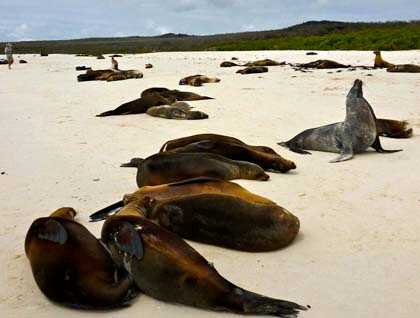Today we anchored at Gardner Bay, on the northeastern end of Española Island. The oldest of the 19 islands of the Galápagos, Española is located on the southeast corner of the archipelago.
After the snorkel and kayak briefing, we split up into different groups for our morning activities. Some guests went to the beach for snorkeling lessons, while other preferred to relax on the white sands of Gardner Bay. A group of more adventurous guests joined me for deep water snorkeling.
The water temperature was a little cold around 68F but visibility was great and there was a lot of activity underwater. Some sea lions joined us, making our experience even more fun. Our diving site was full of colorful reef fish, including parrotfish, damselfish, surgeon fish, Mexican hogfish and many more. After spending an hour in the water, it was time to head to the beach to join the rest of the group. Some guests went kayaking, another optional activity of the morning.
In the afternoon, a short navigation took us to a different location: Punta Suarez. This place is one of my favorites in the whole archipelago at this time of the year. What makes it so special is the presence of the largest of the Galápagos seabirds, the waved albatross. Waved albatrosses spend most of their lives flying or floating on the ocean. They only land during their breeding season, which is now. What a privilege to share the island with such magnificent birds. After landing at Punta Suarez, the westernmost point of Española, we walked through a trail lined with marine iguanas, sea lions, Española lava lizards, and Galápagos doves. Finally we reached albatross territory, where we saw albatrosses courting, incubating their eggs, taking care of their chicks, and just soaring in a majestic way over the cliffs of Española.
At the end of the day, the setting sun painted the sky with bright colors, marking the time to head back to the National Geographic Endeavour to finish another great day in paradise.







